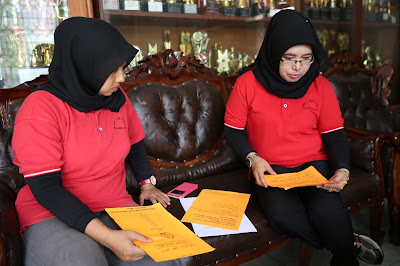 |
| Students walk along a street as they are released from school to return home earlier due to the haze in Jambi, Indonesia’s Jambi province © Antara Foto/Wahdi Setiawan/Reuters/29 September 2015 |
Palangkaraya: “Haze made me feel like I don’t want to be here anymore, ever!” said Gibran, a fourth-grader from Palangkaraya, East Kalimantan.
It wasn’t easy to listen to Gibran recount life during the 2015 haze in his corner of Indonesian Borneo, a weekslong event some have called the 21st century’s worst environmental disaster. In his village, the haze got so bad he and his family couldn’t stay. They were evacuated hundreds of kilometres away to Java, where they stayed for some two months with his grandmother.
Haze is, simply put, acrid air pollution spread by agricultural fires. It not only creates economic losses, greenhouse gas emissions, and wildlife death, but poses major respiratory health risks, especially to children. Underlying issues like malnutrition, diarrhoea and malaria, as well as incomplete immunization, can increase their vulnerability. And when haze hits, schools close, depriving children of an education.
Together with my colleagues from PulseLab Jakarta, Lody and Fahmi, I am working with the Ministry of Women Empowerment and Child Protection, the Government of Palangkaraya and an array of other partners to understand haze from a child’s point of view. The goal is to identify solutions – both political and material – ahead of the dry season, when the haze-belching agricultural fires return. A strong emphasis has been placed on co-design processes, which brings the users of potential solutions together with designers and decision-makers.
In that vein UNICEF and partners have developed a series of prototypes that address various aspects of the haze. The prototypes include things like a comic book on protecting oneself from haze, and a programme where adults can volunteer to help keep kids active indoors during haze. By allowing local communities to participate in the design and testing of these prototypes, we hope to tailor them to local realities to give them a greater chance of success.
 |
| Gibran (centre) and his friend David shared feedback on PulseLab’s comic book prototype on raising awareness on haze © UNICEF Indonesia/2017/Vania Santoso |
It was clear in our discussions with locals that haze’s risks to health and education are often mutually reinforcing, and that these communities crave workable solutions.
David, a 6th-grade student at (SDN) 4 Menteng, a public elementary school in Palangkaraya, remembers vividly how bad the haze got back in 2015. “It was very dark during the day, even inside my house with the lights on,” he shared, “I had a hard time breathing, and I could not play with my friends,” he added.
“The school closed, which was quite difficult, as the school just gave us homework we were supposed to study and do by ourselves,” he said.
Indeed, schools often close during haze episodes, for weeks on end.
“It was like living in a jail! My house is small and the children wanted to go outside and go to school to play with friends,” recounts Mrs. Elok, a parent and local teacher. “Children were not aware of the dangers and they go outside anyway without our permission.”
According to Mrs. Ernawatie, the school principal, “During haze, children are exposed to negative health impacts. Almost all children, including my own, become more vulnerable to disease, cough a lot, and some even develop long term respiratory problems.”
 |
| Ibu Elok (left) and Ibu Ernawatie give feedback on PulseLab’s emergency response curriculum prototype © UNICEF Indonesia/2017/Vania Santoso |
Mrs. Ernwatie says she is excited by a "haze-free shelter” prototype developed by UNICEF, and is eager to implement a potential curriculum from PulseLab Jakarta on haze emergency response strategies.
“It’s been a dream of mine to build a shelter with basic facilities so children can gather, play and study when the haze strikes,” Mrs. Ernwatie said.
Next month, UNICEF will begin testing some of these prototypes in Palangkaraya, and the hope is that some of them will show promise. Haze, however, is a complex issue that will require robust policymaking to mitigate the many harmful effects. With the world marking World Environmental Day on 5 June, it is time to find solution to the haze problem!
